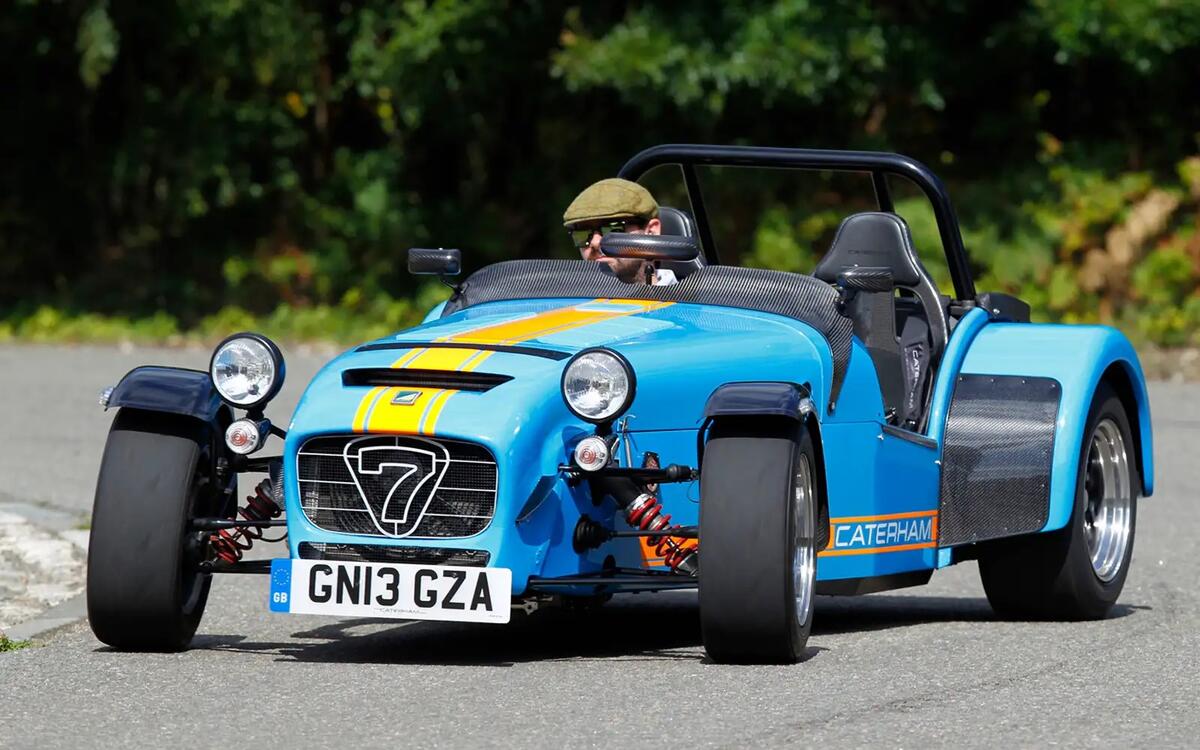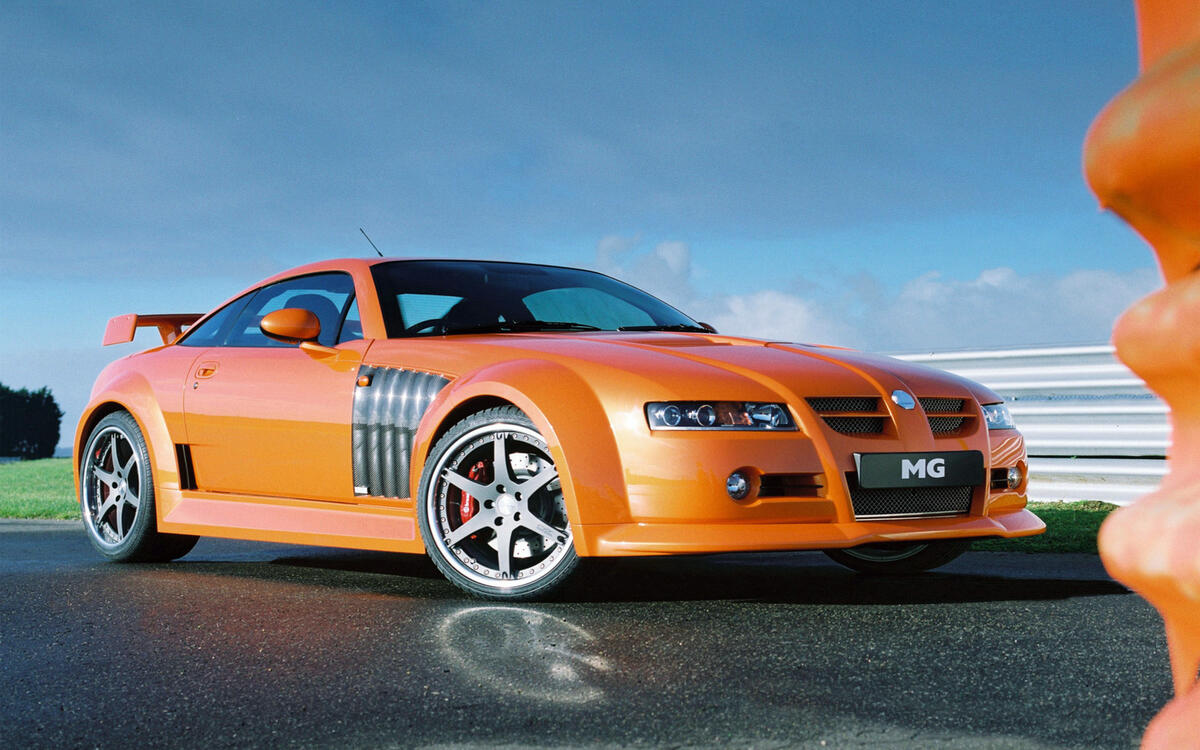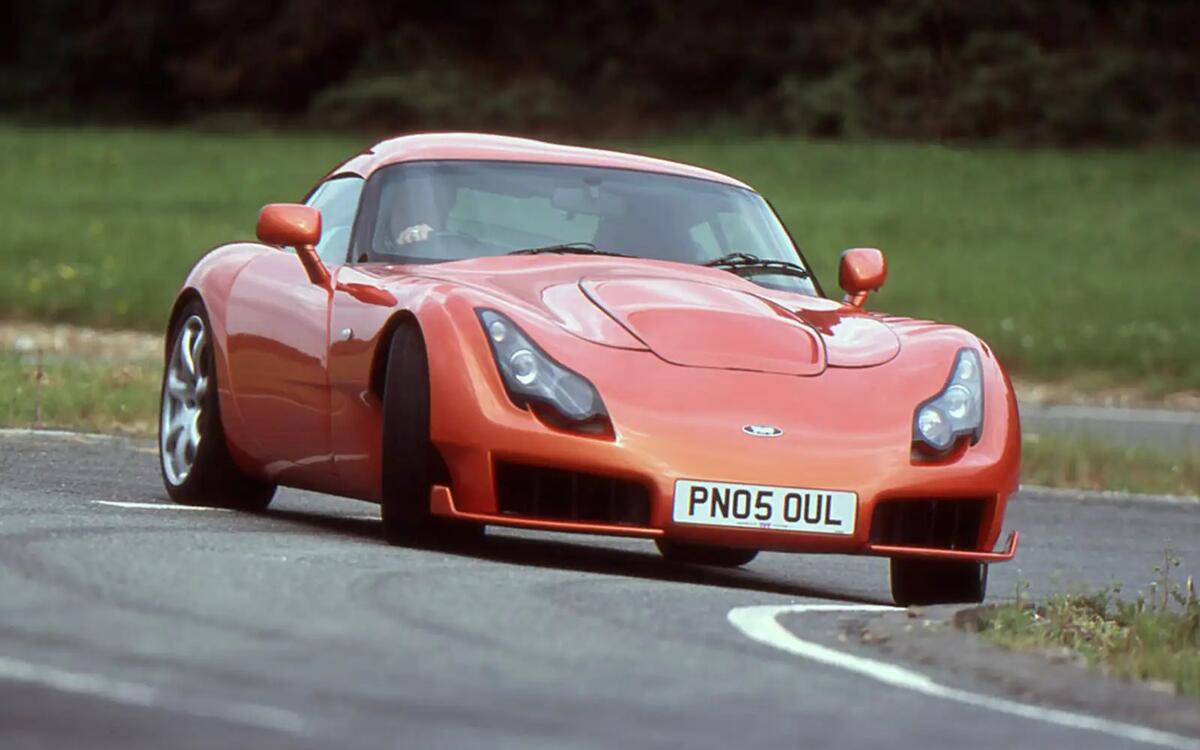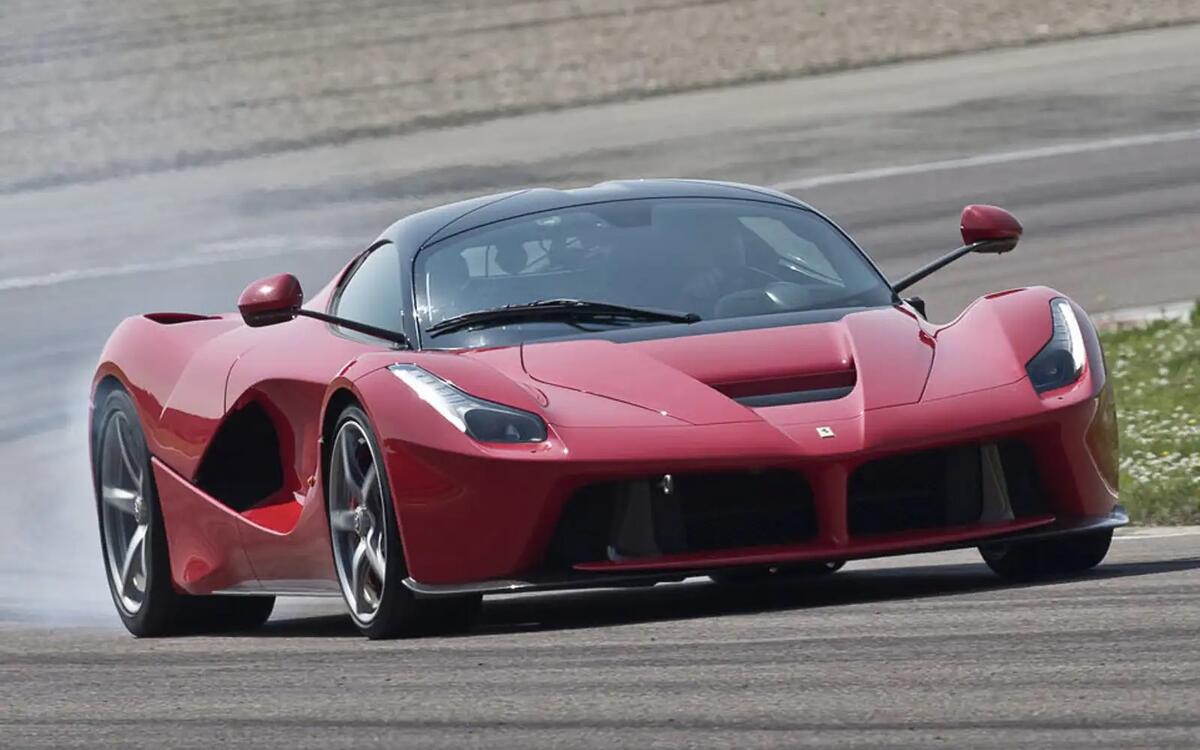 Slide of
Slide of
It’s easy to throw performance modifications at a car nowadays and achieve power figures from a hatchback that only supercars were capable of.
Using lightweight components, you can achieve some exhilarating acceleration without having stacks of power. These are the modern-era champions:
 Slide of
Slide of
MG XPower SV-R
MG’s aggressive XPower SV one-off was unveiled in 2002. Fins, vents, a big spoiler, designed by Peter Stevens of McLaren F1 fame, and a 320bhp 4.6-litre Ford V8 helped match the performance to its looks. To combat the poor sales figures on release in 2003, MG decided to build 42 go-faster versions called the SV-R. 385bhp was now on offer from a 5.0-litre V8 and while the complete shell weighed just 65kg, the total 1495kg mass gave a 257bhp per tonne figure.
 Slide of
Slide of
Mercedes-Benz C63 AMG
As things go greener, older hot V8 Mercedes are becoming increasingly sought after. The W204 C63 AMG fed 451bhp and 443lb ft from its 6.3-litre V8 to the rear wheels, trumping its E90 M3 competitor by 37bhp and 148lb ft. Put your foot to the floor and the C63 would quickly climb through all seven gears of the automatic gearbox, eventually reaching a limited 155mph top speed. Its steel body weighed 1728kg, which gave the C63 AMG 261bhp per tonne.
 Slide of
Slide of
Aston Martin DBS
What was essentially a sportier version of the DB9, the DBS shared the same V12 but had bigger inlet ports and a higher compression ratio raising the power from 450bhp to 510bhp. This meant the DBS was capable of 191mph and a 0-62mph time of 4.3sec in comparison to the DB9’s 4.7sec. Flared arches and aggressive bodywork helped to differentiate the DBS from other models, whilst underneath the makeup were various carbonfibre components, resulting in a 65kg saving over the DB9. This meant the DBS weighed 1695kg and offered 300bhp per tonne.
 Slide of
Slide of
Noble M12 GTO-3R
About 20-odd years ago, a car appeared on the market that confused many – the Noble M12 GTO. The Noble badge was unheard of and although the M10 had already been released, company founder Lee Noble relied solely on the press for promotion as he never had the budget to push it much. When introduced in 2000, the M12 GTO used a twin-turbo 2.5-litre Duratec V6 producing 310bhp but the GTO-3R saw a new 352bhp 3.0-litre twin-turbo V6. This meant that the lightweight 1080kg GTO-3R could crack 0-62mph in 3.7sec and offer 325bhp per tonne.
 Slide of
Slide of
Ultima GTR
With few competitors that match its performance and looks, the Ultima GTR offers track day performance in a usable road car. Designed in the MIRA wind tunnel, Ultima spent valuable time ensuring that the GTR’s aerodynamics were spot on, and the result was a car that could hit 160mph with just a 350bhp Chevrolet V8. While 160mph wasn’t groundbreaking in the early 2000s, its 950kg (2094lbs) weight meant 0-100mph was over in 5.3sec, and it would go past 150mph in 10.4sec. With such little weight, the GTR gave 368bhp per tonne.
 Slide of
Slide of
Jaguar XJ220
A name that sits comfortably beside the Ferrari F40 and Porsche 959. Like its rivals, the XJ220 had a twin-turbo setup but it was tied instead to a mid-mounted 3.5-litre V6 – originally, it was to receive a racing V12 but this was penned out. The Jaguar achieved 542bhp and a 0-140mph time of 14.9sec, whilst the aero generated 1360kg of downforce at 220mph. Overall, the XJ220 weighed 1456kg, this meant 372bhp per tonne which was more than a Lamborghini Murcielago LP640.
 Slide of
Slide of
KTM X-Bow R
Austria’s KTM are more known more for motorcycles than cars but the X-Bow was their go at an ultra-light car, inspired by GT racing cars. The first X-Bow used a 237bhp 2.0-litre Audi engine, but when the updated X-Bow R arrived, this received a new turbo and cylinder head to produce 295bhp, later variants had a 2.5-litre from an Audi RS3. Weight was just 790kg, thanks to a carbonfibre tub, which gave 373bhp per tonne, allowing it to accelerate to 62mph from rest in 3.9sec
 Slide of
Slide of
TVR Sagaris
Around 200 Sagaris’ were built with production running from 2005 to 2006. Underneath the unworldly bodywork was a 4.0-litre straight-six that fed 406bhp and 270lb ft through the rear wheels. It was quickly labelled as one of the rawest sportscars that £49,995 could buy due to it having no airbags, no ABS and no traction control. Vents sat on each wing of the prototype model but these were filled in on production models to stop stones from being picked up from the tyres hitting the windshield. In a bid to keep weight low, TVR carried over the bare-bones interior as found in previous models, which resulted in an overall weight of 1078kg and 376bhp per tonne.
 Slide of
Slide of
Ascari KZ1
Powered by the old BMW M5 V8, Ascari managed to extract 500bhp for the KZ1 and fed it to the rear wheels through a six-speed manual gearbox. A carbonfibre monocoque chassis meant weight was kept low at 1275kg, which gave 392bhp per tonne and an achievable 200mph top speed. When released in 2004, it was priced at around £100,000, north of its Ferrari F340 and Lamborghini Murcielago rivals. Ascari cars filed for bankruptcy in 2010.
 Slide of
Slide of
Lotus Exige Cup 430
The standard Exige offered Porsche-rivalling performance and looks but Lotus managed to squeeze 430bhp and 325lb ft from the 3.5-litre supercharged V6 for the Exige 430. New carbonfibre bumpers, aerofoils and bodywork meant 220kg of downforce at a 180mph top speed and a dry weight of just 1056kg, resulting in 407bhp per tonne. 0-62mph was cracked in 3.2sec and it managed a 1m 24.8sec around Helthel’s test track, which was 1.2sec quicker than a road-spec Lotus 3-Eleven.
 Slide of
Slide of
Ferrari F50
Striking looks, coupled with a Formula 1-derived 513bhp V12 and a six-speed manual gearbox, meant that Ferrari had created one of their most driver-rewarding cars at the time. Built in 1995 to celebrate 50 years of Ferrari, the F50 strayed from the turbocharged powerplant used by its F40 predecessor and reverted back to its naturally aspirated roots. 0-62mph arrived in 3.7sec and a 200mph-plus top speed was achievable, while 1230kg meant 417bhp per tonne. An electronic damper control system was used to optimise ride and handling depending on the road conditions, while the suspension used a pushrod system to keep to its F1 roots.
 Slide of
Slide of
Maserati MC20
Named “The first of its kind” by Maserati, the MC20 uses a monocoque chassis that weighs just 100kg while the total car weight comes in at 1475kg. A twin-turbocharged 90-degree V6 produces 621bhp and 538lb ft allowing for 421bhp per tonne, a 203mph top speed and a 2.9sec 0-62mph dash, rivalling the likes of the Ferrari F8 Tributo and Porsche 911 Turbo. Selectable electronic driver modes include GT, Sport, Corsa and Wet allowing the driver to switch between each depending on the thrills required.
 Slide of
Slide of
Zenos E10 R
The E10 R still holds the record for being the fastest, and most focused, Zenos car to date. In comparison to the base E10, the E10 R got higher spring rates, retuned dampers and lightweight wheels that shaved off 10kg. A 2.3-litre EcoBoost engine was robbed from a Focus RS and produced 350bhp and 350lb ft allowing the 700kg E10 R to offer 500bhp per tonne and barrel onto 155mph while hitting 62mph from rest in 3.0sec. Underneath was an extruded aluminium spine that was bonded to a composite carbonfibre tub.
 Slide of
Slide of
McLaren 720S
0-62mph in 5.6sec is still considered rather rapid. The 720s not only manages to hit 100mph from rest in that time but will also hammer onto 212mph. Underneath the sleek bodywork is a twin-turbocharged 4.0-litre V8 which develops 710bhp and 568lb and is mated to a dual-clutch seven-speed flappy paddle transmission. A one-piece monocoque chassis contributes 102kg to the 1419kg kerb which means the 720s gives 500bhp per tonne.
 Slide of
Slide of
Caterham 620R
Once described as the most potent and hardcore Seven yet, the R500 was replaced by the 620R. Keeping to the Ford-derived powerplant theme that Caterham has followed since 2006, the 620R has a supercharged 2.0-litre that produces 311bhp, coupled to a six-speed sequential gearbox with flat-shift – there are no electronic aids to tame any wheelspin. Tipping the scales at just 545kg, the 620R gives 569bhp per tonne which is more than a standard Bugatti Veyron has to offer.
 Slide of
Slide of
Bugatti Veyron Super Sport
Once, Veyron shook the world with almost 1000bhp and a 253mph top speed, but its victory was short-lived after Shelby Supercars (SSC) stole the world record with its 257mph SSC Ultimate Aero. Bugatti had to win back the title and a few years later the Veyron Super Sport arrived with a tuned variant of the 16.4-litre W12 giving 1183bhp and a 268mph top speed. A full-carbon monocoque meant 1990kg, slightly heavier than the normal Veyron, giving the Super Sport 594bhp per tonne.
 Slide of
Slide of
Ferrari LaFerrari
The Ferrari LaFerrari followed in the footsteps of many other Ferrari legends such as the 288 GTO, F50, Enzo and F40 and was the first Ferrari to feature a mild-hybrid drivetrain. It was priced at £1 million when new and aimed at the Porsche 918 and McLaren P1. Buyers received a supercar with a 6.3-litre V12 developing 789bhp and revving to 9250rpm aided by a 160bhp electric motor driving through the differential. This means 950bhp and, with a weight of 1255kg, a 756bhp per tonne figure.
 Slide of
Slide of
Arial Atom 500
Atoms of old had the 2.0-litre Civic Type R unit but then Arial dropped a 500bhp 32-valve 3.0-litre V8, derived from a pair of Suzuki Hayabusa motorcycle engines, allowing it to rocket to 62mph from a standstill in 2.3sec. It was mated to a six-speed sequential gearbox which meant 100mph could be achieved in 5.4sec. The Atom has been described by many as a scaffolding frame with two seats, some headlights and an engine. which gives it an ultralight weight of 550kg and a remarkable 909 bhp per tonne figure.
 Slide of
Slide of
Koenigsegg One
Sitting high in the ranks amongst the world’s fastest and most powerful cars, the Koeniggsegg One was introduced in 2014 with 1340bhp and was marketed as producing one megawatt of power. It could run on a variety of different fuels such as regular fuel, performance fuel, and E85 biofuel which would restrict the power from the twin-turbo 5.0-litre V8 to 1160bhp. Performance claims were 0-250mph in 20sec and 0-62mph in 2.5sec with a 1360kg weight which means 985bhp per tonne, if you use the right fuel.
 Slide of
Slide of
Hennessey Venom F5
The current winner of the power-to-weight game is the Venom F5 and all of its 1817bhp and 1360kg weight. Use of an 86kg carbonfibre monocoque and a rear tubular aluminium subframe, which holds the 6.6-litre V8, means 0-186mph in around 8.4sec, 0-125mph in 4.7sec and 0-62mph in 2.6sec, with a top speed of circa 300mph. While the Venom GT of old used a heavily modified Lotus chassis, the Venom F5 was built entirely in-house. 24 examples were built and boast 1336bhp per tonne.
Access control:
Open











































